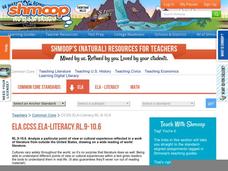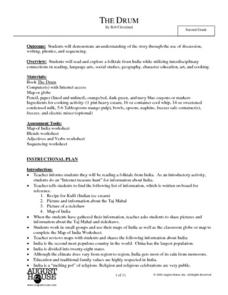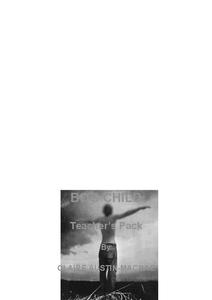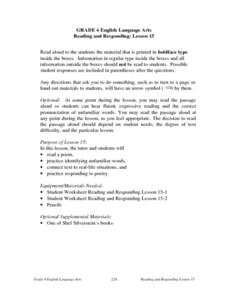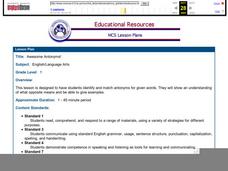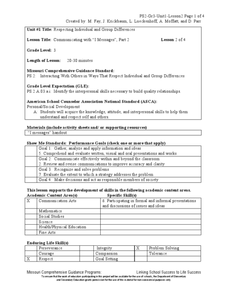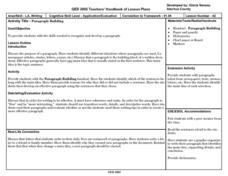American Press Institute
Introductory News Literacy
Aspiring journalists learn about media literacy, journalism, and the press. Units come complete with handouts, assignment rubrics, notes, and extension suggestions. Each unit also comes with a list of vocabulary words and learning...
Shmoop
ELA.CCSS.ELA-Literacy.RL.9-10.6
Being able to identify and understand the point of view of fictional characters across a wide range of time periods, places, and cultures is a skill that is necessary for becoming a proficient reader. It is also a skill identified in the...
August House
The Drum
Take a journey to India with a read aloud of The Drum: A Folktale from India by Rob Cleveland. Make connections to the story's theme by building and practicing drums, role playing story characters, and practicing skills in phonics, math,...
Curated OER
Pizza Biography
A biography writing lesson with a tasty twist! Kids create a "visual biography" in which each pizza slice represents a paragraph, and toppings represent supporting details. They learn research techniques, note-taking skills, and how to...
Perkins School for the Blind
What Would You Do If...?
What would you do if...? That's a great question, and, when posed to learners with visual impairments, a question that can foster concept development and speaking and problem-solving skills that relate to real-life situations. The...
Poetry4kids
How to Create a “Found Poem”
Writers compose an original found poem by searching for words that inspire them. Words are taken from everyday conversation, books, cut from magazines, the mail, or an already written poem.
Curated OER
Bog Child
You are destined for an engaged and happy class as they read Siobhan Dowd’s Bog Child because there is nothing missing from this study guide, seriously. This might be the easiest novel to teach because you don’t have to do a thing in...
Family & Children's Service
Children in Change
While children may not have the opportunity to directly affect the changes happening in their family life, help them develop necessary coping skills for expressing their emotions and dealing with those changes.
Curated OER
Reading and Responding -- Lesson 15
Fourth graders work independently or in a small group to (1) read a poem, (2) identify unfamiliar words, (3) connect text to real-life situations, and (4) respond to poetry. Reading passage, comprehension questions, and teacher script...
Perkins School for the Blind
Let's Pretend
Playing pretend with real objects or concepts is a wonderful way for learners to make object-to-action connections, as well as practice daily living skills. Learners with visual and intellectual disabilities use a wide variety of real...
Curated OER
Awesome Antonyms
Review with your young learners what opposites are and use a fun tag board game called Auntie Alice to practice. After the class plays the game, pairs work on computers practicing with interactive matching/flashcards/concentration games...
Curated OER
Matching Games, Trees and Animals
Students identify and define new words as they are introduced to specific trees, leaves, animals and animal habitats, engage in literacy-related play by playing games that focus on animals and trees mentioned in book, A Tree for Me, and...
Curated OER
Communicating with "I Messages", Part 2
Third graders listen to ways they share their feelings with others. After brainstorming situations where "I messages" would be appropriate, pairs of students write messages from the lists they developed. They discuss how their messages...
Perkins School for the Blind
Telephone Skills
What kid doesn't love talking on the phone? Learners with visual and intellectual disabilities get comfortable using several types of telephones. They begin by examining the phone, dialing, answering the phone, and then they work into...
Agriculture’s Lasting Heritage
Apples Around Us
Apple tasting launches an investigation of the story and travels of John Chapman, also known as Johnny Appleseed. After listening to his story, class members craft a summary of the tale, chart his journeys on a map, and sample different...
Curated OER
Shapes
Fifth graders explore shapes. They recognize and name two-dimensional and three-dimensional shapes. Pupils discuss the properties and criteria for each shape they find in real life and construct a Kid Pix project using pictures of the...
Curated OER
Recognizing Cause and Effect
Students define cause and effect and recognize an effect as something that happens as a result of a cause. They apply information they have learned about cause and effect to their study of literature.
Curated OER
Paragraph Building
Build the skills your budding authors need to develop to compose well-structured paragraphs. Give them the topic sheet (included here), and have them write a cohesive paragraph using the ideas listed. Consider having them include two...
Curated OER
Making a Grocery List
Pupils assess a variety of reading strategies to properly develop a list of grocery words. They draw conclusions about environmental print by matching labels to sentences. Real-life words utilized weekly becomes an asset to the shopping...
Curated OER
The Thinking Approach to Reading
Young scholars discover to how to tell what a passage is saying and different types of reading. They relate the situations to real life situations.
Syracuse University
Ancient World Writing System
Most twenty-first century pupils don't know how to interpret cuneiform. Examining images of cuneiform and papyrus writing and using a chart and Venn diagram, young historians extrapolate what life may have been like for people who lived...
Curated OER
First Degree Equations
Learners establish a solid competence in solving all types of equations and a solid understanding of how variables and equations can be utilitzed to solve real life problems.
Curated OER
Conflict Transformation
Students analyze the usefulness of conflict. In this conflict resolution lesson, students will examine several real life conflict scenarios. Students will analyze these conflicts in terms of there costs and benefits to determine weather...
Curated OER
Statistical Pictures of School and Life
Students explore how mathematical data is used to summarize and illustrate everyday life. They apply mathematical concepts and skills to analyze data. Students conduct a five question survey of 50 people or more and graph the data.



